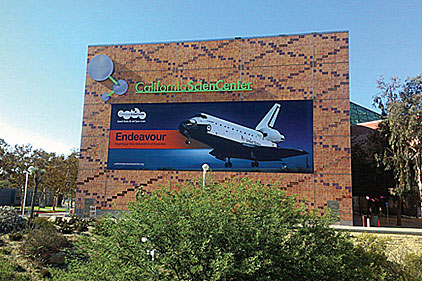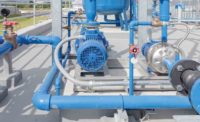 The space shuttle Endeavour is a survivor.
The space shuttle Endeavour is a survivor.
The newly retired spacecraft successfully navigated 123 million miles of outer space elements during 25 missions and even survived a tricky piggyback flight from Northern California atop a modified 747 aircraft to Los Angeles’ LAX airport. Its 2-mph ground transport victory lap last October through south Los Angeles’ streets to its new museum home at the California Science Center’s Samuel Oschin Pavilion required dozens of precarious zigzags around tight corners, trees, telephone poles, and other obstacles.
Instead of NASA, Endeavour’s protection from earthly elements for the long haul of museum exhibiting now rests on the designs of two ARUP (Los Angeles) principals: structural engineer Atila Zekioglu, S.E., and mechanical engineer, Erin McConahey, P.E., LEED® AP, BD+C. Also integral to the Pavilion’s design was architect Zimmer Gunsul Frasca Architects LLP (Los Angeles); and Tony Budrovich, deputy director for operations for the California Science Center.
SEISMIC DESIGN
McConahey sees the potential of a catastrophic earthquake as one long-term risk to the Endeavour. The vaulted 17,000-sq-ft metal building manufactured by Kansas City-based Butler Manufacturing and erected by T. Viole Construction Co. (Tarzana, CA) surpasses California seismic building codes, according to peer reviews.
Likewise, Arup avoided MEP elements above the shuttle except for the necessary six runs of overhead HVAC ductwork. Consequently, McConahey specified lightweight fabric air dispersion duct manufactured by DuctSox Corp. The ducts and their independent cable suspension systems would more likely swing to dissipate energy under the violent shaking of a seismic event, compared to typical spiral metal duct and its anchoring system. Moreover, should the overhead ductwork become dislodged, the textile ductwork would be far more forgiving to the Endeavour’s fuselage than potentially damaging falling metal ductwork, according to McConahey.
While textile duct is typically specified for its aesthetics, air dispersion, 80% lighter weight, energy efficiency, and labor installation cost advantages, McConahey’s seismic precautions may chalk up yet another benefit, at least in earthquake-prone California. “I chose fabric duct because if it fell during a high-magnitude seismic event, there would be minimal damage to the Endeavour as opposed to metal duct,” said McConahey.
Other seismic precautions include Endeavour’s four seismic isolators provided by Earthquake Protection Systems Inc. “The seismic isolators significantly reduce the earthquake forces imparted to the orbiter and allow the shuttle to float while the ground below it moves,” said Zekioglu.
TEMPERATURE CONTROL AND AESTHETICS
The combination of the U.S.-made fabric duct and the two custom AHUs provided by Energy Labs and DMG Corp., will keep the Endeavour, as well as an expected million-plus visitors annually, in a comfortably controlled environment. McConahey worked with Toro-Aire, a Dominguez Hills, CA-based manufacturer’s representative for air management products, to ensure the duct’s specified 2-1/2-in.-diameter orifices would provide air throws as long as 70-ft to ground level. Each of the six 112-ft-long duct runs rise up the vaulted ceiling at a 27-degree angle in parallel to the Pavilion’s steel support arches. At the apex, a 54-degree elbow reroutes each run down toward the opposite side to an end cap.
The one disadvantage of textile duct — mainly its tendency to unappealingly sag or wrinkle during idle air handler periods — will not be a problem at the Pavilion, because it’s one of the nation’s first uses of DuctSox’s SkeleCore™ FTS (Fabric Tensioning System), a patent-pending lightweight metal framework system. According to the manufacturer, it is the HVAC industry’s first textile cylindrical air duct that allows the installing contractor to field-tighten the framework with a wrench and draw the fabric taut and wrinkle-free. Thus it displays an inflated appearance — even during idle air handler periods — and eliminates the typical “popping” sound as it fills with air during equipment start-up.
“It looks nicer than spiral metal ductwork,” said Monika Iannone, project engineer for the Pavilion’s mechanical contractor, Limbach Inc., Garden Grove, CA.
The factory-engineered white textile duct arrived via United Parcel Service and installation required three Limbach installers, an 80-ft scissors lift and only three work days, according to Iannone.
The two Energy Labs 10,000-cfm, 43-ton air handlers deliver conditioned air to a 40-ft-high, 100-ft-long, 72 x 32-ft rectangular metal plenum that supplies each of the 22-in.-diameter textile runs. The two units’ shared riser offers a redundancy advantage as well as an energy-efficiency opportunity of running one unit during unoccupied periods. American Air Balance Inc. tested the air distribution system and calibrated plenum dampers supplying the textile ducts.
The air handlers have cooling and heating coils supplied by the campus’ chilled water and hot water central plants. The hot water coil is mainly for outdoor air heating and the dehumidification feature on the air conditioning coil keeps the exhibit area within a comfortable rh range. The campus-wide Delta Controls BAS monitors the exhibit. Active humidification is not provided in any of the other California Science Center facilities, because Southern California rh rarely falls below 30%. In the event of low rh, the BAS signals an alarm so that portable humidifiers can be temporarily added to the space. Setpoint Systems Corp. interfaced and programmed the Pavilion’s HVAC operation with the campus-wide BAS operation.
The Pavilion is a temporary home until the Shuttle is moved into California Science Center’s new Samuel Oschin Air and Space Center, an expansion that’s scheduled for completion in 2017. In the meantime, the Pavilion will serve as a comfortable exhibit space due to the design care that engineers, architects, and contractors built into it.





